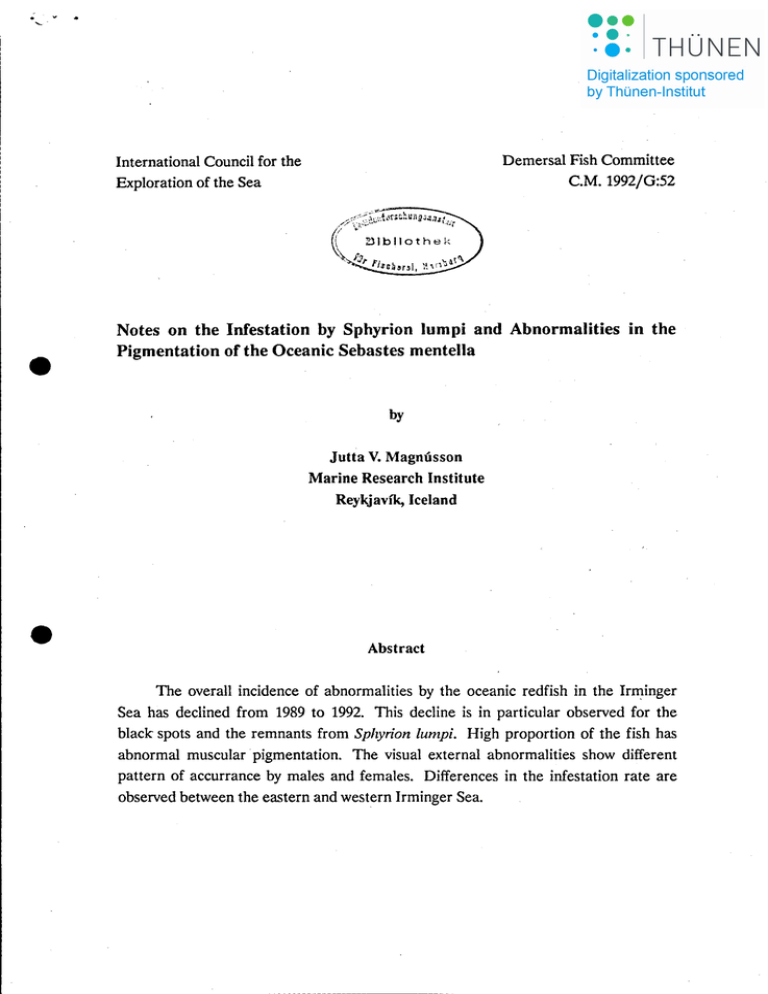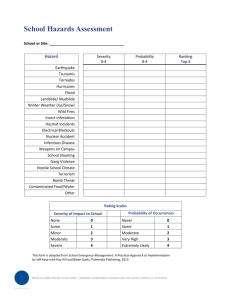•
advertisement

• ...... . VI • Demersal Fish Committee C.M. 1992/G:52 International Council for the Exploration of the Sea • Notes on the Infestation by Sphyrion lumpi and Abnormalities in the Pigmentation of the Oceanic Sebastes mentella by Jutta V. Magnusson Marine Research Institute Reykjavik, IceJand Abstract The overall incidence of abnormalities by the oceanic redfish in the Irminger Sea has declined from 1989 to 1992. This decline is in particular observed for the black spots and the remnants from Sphyrion lumpi. High proportion of the fish has abnormal muscular pigmentation. The visual external abnormalities show different pattern of accurrance by males and females. Differences in the infestation rate are observed between the eastern and western Irminger Sea. -2- Introduction The characteristics of the stock identification of the oceanic Sebastes mentella (Le. oceanic redfish) are described in the first report of the Study Oroup on oceanictype S. mentella (leES, C.M. 1990/0:2). Apart of it is the description of an abnormal external coloration and the infestation of the parasite copepod Splzyrion lumpi as weH as of the lesions caused by the remnants of the parasite. The existence of aseparate peldgic stock ofS. mentella in the Irminger Sea was known since 1972 (Magm1sson 1972). . Already then, .it . was observed that this particular stock was heavily infested by Splzyrion lumpi and that the abnormalities in the pigmentation were common. In 1977, a short account on the infestation rate and on the abnormal coloration was given (Magnusson 1977). At that time, the fishing industry was not yet interested in processing oceanic redfish because of the decreased yield caused by these infestations and the other abnormalities of the fish although, by then, it was already assumed that thestock was large. ~ However, in 1982, the commercial fishery commenced and has been carried out since then, although the infestation is still having a considerable impact on the utilisation of this stock. Therefore, the intensity of the infestation is of important economical interest. Since the beginning of the commercial fishery on oceanic redfish information on the abnormalities of the species are available, e.g. Reinert (1987), Bakay (1988), Bogoyski et aI. (1989). In the short history of the Icelaridic' fishery on this stock (Le. since 1989), information have been collected on the species (Magnusson et aI. 1990, 1992a, 1992b) La. on the abnormalities of the fish of which some aspects are presented here. Material and methods The data were collected on' board commercial' vessels, sampIes taken from commercial catches and from catches of research cruises. The area in question was the Irminger Sea mainly north of 59°N and the time period of sampling was April to July, during the years 1989-1992. Systematic recording of the external infestation and • • ·.' '- : :'.' ")'.;' -3- of abnor~al pigment,ation has been carried out during all four years but the systematic evaluation of the muscular pigmentation was commenced in 1991. Also, in 1991, the tabulating of the Visual external abnormallities according to body seetions was started. The body was divided into 8 different sections on each side (Fig. 1). In 1989 sampling procedures were developed and the criterias partly not fully defined. All the sampies in that year were from commercial catches while in 1990 to 1992 sampies were from both research cruises and commercial catches. Five categories of the external abnormalities of oceanic redfish were applied in • this study from the beginning and they are as follows: black spots, red spots, mixed spots, remnants and/or'lesions caused by the parasite Splzyrion lumpi and Splz. lwnpi itself. The muscular pigmentation was categorized as light~ medium and severe. The material was tabulated to receive information on the overall infestation rate, on the incidence sex. of the different categories and on the differences in ihis respect according to Same records from the commercial fishery on the yield of processing by weight were available, of the year 1992.. The division of the area in question into an eastern and western part is defined by' a line through the following positions:' 62°00'N 35°00'\V and 59°30'N 37°00'W. . .. . Results • During this, time series (1989-1992); the occurrence of the overall' external . infestation by Splzj'rion lumpi and of abnormal pigmentation, has ,~ecreased markedly from about 69% in 1989 to about 43% in 1992 indicatinga trend towards a decline of the incidence of abnorrrialities (Table 1).. ~is trend is supported by the observations' of Icelandic commercial fishermen that the general appearance of the oceanic redfish has improved considerably since the beginning of the fishery, in 1989. ,However, the incidence of external abnormalities varied greatly even from one haul to another. This was the case both for commercial and for research vessel catches. The discard by the commercial' trawlers because of the abnormalities' of the fish and damagesranged from about 16% to 26% per trip in 1992. . In Table 2, tbe incidence of visual external infestation and of abnormal pigmentation is demonstrated for the years 1989 to 1992 by kind of infestation and - 4- abnormal coloration. : The .overall infestation for Sph. lumpi and remnants combined show some decline from about 38% and 39% in J989 and 1990respectively to 32% in 1992. The remnants show a definate decline from about 29% in 1989 to 1S%.in 1992, while the infestation rate by Splzyrion lumpi proper· does not show a declining trend rather the contrary. But there is a steady decline in the occurance of black spots from about '" 27% in 1989 to 17% in 1992. .. .' In Table 3 the incidence of abnormaL muscular pigmentation is shown for the years 1991 and 1992. Part A shows the incidence for all the fish examined, and part B f,?r fish with external infestation. About 40%J. of all fish examined in both years, .1991 and 1992, were free of abnormal muscular pigmentation. It .should be mentioned that all three. categories of muscular pigmentation were also observed in fish without external infestation and that fish.with external infestation wereJrequently observed without any muscular pigmentation, e;g. it was about 36% and 28% in 1991 and 1992 respectively..Thus, there is no obvious connection between the external and muscular abnormalities. However, the Table might indicate a possible·linkage inthe frequency of. muscular. pigmentation on the one hand and/or external infestation on. the other '., hand which is a subject forJurther studies. . The infestation rate is much higher for females than for males in all four years of observations varying from 66% to 74% of the infested fish. Tbe overall infestation rate in 1991 was 12.7% for males and 36.3% for females and the corresponding figures for 1992 were 14.2% and 29.2%. Tbe incidence of all five categories of external· abnormal coloration and infestation bybody sections (see' also Fig. 1) is summarized for the years 1991 and 1992 .in Table 4,; for . males' and females separately.Tbe; occurrence·· of. the abnormalities per body section,were markedly different between males and females. Thus, e.g. for males" the head region was more commonly infested than for females and on the other hand, f<:>r females the body sections were much heavier infested. Tbe infestation of the tail region was similar for both sexes.The heavy infestation by Splz. lumpi and its remnants were observed to be mainly located in the abdominal region of the females while the abnormal pigmentation accounted for the majority of incidences in the body seetions 3 and 4. During the research cruises in 1991 and '1992, it was obsenied that the abnormalities were more common in the eastern. part of the survey area than' in the • • -5- western one (Table 5). A possible explanation could be the lower infestation rate of males which were more common in the western part. In general, the heaviest infestat,ion rate was observed on the largest females which were more common in the ' eastern part at the time of the surveys. " I, .i Discussion '. The infestation by Sp/zyriOil lumpi and the lesions caused by, it is not o,nly of biological i~terest, e.g. as biological 'tagging etc. but also. considerable 'co~cerri for . . , the fishing industry. The discarding. of ,fish because of. th~ "i~estation . before processing is relatively high. It is known that parasitical infestation of virgin stocks may decline considerably with increasing exploitation. Such a decline of infestation by Sph. lumpi in redfish is known from the Faroe Islands (J. Reinert; pers. communic.). : .' ,The decline in the overall infestation rate (Table 1) might indicate this trend as .' I ." .' weIl as the observation of the fishermen that the appearance of the fish had approved. It cannot be excluded, however, that the indicated declining trend in the overall infestation may partly be due to the sampling time und area; , , No' trend in this respect can be noted by the infestation by Splz. lumpi~ But it is obvio,us in the declining number of fish with remnants and black spots. The declining i~~edence ~f the remnants ~nd in particular of. the' black spot~ wo~ld' ce'~tainiy improve' . " . the appearance of the fish considerably. ,' It has been suggested that the muscular pigmentation might be caused by the infestation: Su'ch origin cannot be excluded although severe muscular pigmentation has been observed in fish with no visual external infestation. The frequencies indicate' that there might be some connection as a comparison of part A and part B in Table 3 indicates. ' oi " ' ~ A rather surprising between the sexes were,observed.in'the incidences .difference ' . . of infestation by body sections. Since the males have a relatively high number of infestation in the head region but less on the body sections compared to the females, they should be more suitable for processing. However, in the case of females, the infestation by Sph. lwnpi is partly concentrated around the abdomen. This region would be to a great extent cut away when filletting and thus cause less harm to the fillets than could be expected. " ' " .' ~ - 6- References • . ' . t " Arion., '1990: 'R~port' of the Study Group on Oceanic-Type Sebastes' l1wntella. Reykjavfk, 21-23 Febr. ICES, C.M. 1990/G:2. Bakay, Y.I., 1988: Application of results from parasitological investigations in redfish (Sebastes mentella Travin) populational structure studies. ICES, C.M. 1988/G:35. B()govski, S.P., Y.I. Bakay, 1989: Chromatoblastomas and related pigmented lesions 'in deepwater redfish. Sebastes mentella (Travin), from North Atlantic areas, especially'the lrminger Sea. Joum. Fish. 'Diseasesl989, 12, 1':'13. •~ 1 • Magriusson, J., 1972: ,Tilraunir til karfaveiOa meo miosjavarvörpu luthafinu (English " summary). iEGIR, 21. tbl. :J., MagmIsson, 197'7:' 'Pelagic" Redfish In the' Irminger Sea. , Ahu'ndance. ICES, C.M. 1977/H:43. Distribution and Magnusson, J. & J.V. Magnusson, 1990: Icelandic Investigations on the Oceanic Stock ,of S. mentella in the lrminger Sea, in 1989,and in 1990. ICES, C.M. 1990/0:41. Magnusson, J., J.V. Magnusson, P. ~eynisson, 1992 a: Report on the Icelandic Acoustic Survey· on the Oceanic' Sebastes meniella in the Irminger Sea, in June 1991. ICES, C.M. 1992/G:64. ,Magnusson, J., J.V. Magnusson, P. Reynisson, I. Hallgrfmsson, ,A.,Dorchenkov, A. I Pedchenko, Y. Bakay, 1992 b: ,Report on the Icelandic and Russian Acoustic Surveyon Oceanic Redfish in the Irminger Sea and Adjacent Waters, in May/July 1992. ICES, C.M. 1992/0:51. Rein~rt; J., 1987: Kongafiskur f Irmingerhavinum. Fiskiranns6knir Ni. 4: • -7- Table 1 Oceanic redfish Percentage of external abnormalitics by year Year 1989 1990 1991 1992 No. of exam.fish 1800 1248 69,3 2204 1740 1382 852 62,7 . 49,0 2497 1083 43,4 No. of fish w. abnorm. • % Table 2 Oceanic redfish Incidcnce of visual extcrnal infcstation and of abnormal pigmentation Year No of exam. fish 1989 1800 No fish Black spots Red spots Hi::ed ~r~ts Remnants Sph.lumpi Tot. no. and % 1990 ·2204 % No fish 1992· 1991 1740 % No fish 2497 % No fish 434 132 % 482 148 38 524 166 26,8 8,2 2,1 29,1 9,2 559 250 178 526 332 25,4 11,3 8,1 23,9 15,1 369 156 123 344 247 21,2 9,0 7,1 19,8 14,2 350 450 17,4 5,3 6,4 14,0 18,0 1358 75,4 1845 83,7 1239 71,2 1527 61,2 1~1 ·8·· TabIe 3 Oceanic redfish Incidence ofabnormaI muscuIar pigmentation B) of infested fish A) of total exam. fish 1991 1682 Year No of records 684 595 322 81 None Light !'.1 :~d;urr. Severe 1992 2491 % 40,7 35,4 19,1 4,8 986 1077 327 101 1992 1088 % 1991 % 852 % 39,9 43,2 13,1 4,1 309 321 202 20 36,3 37,7 23,7 2,4 290 596 2S 108 28,4 58,3 2,7 10,6 Table 4 Oceanic redfish Incidence of external abnormal coloration and infestation by body seetions .(both sides) for . 1991 and 1992. (See also Fig. 1)•. 1991 Body Males 1992 Females Males Females section No % No % No % No % 1 2 82 65 20,2 16,0 44 7 2,8 0,5 128 78 16,3 9,9 51 8 2,0 0,3 3 51 12,6 395 25,4 98 12,5 574 21,9 4 38 9,4 389 25,0 71 9,0 597 22,8 5 42 10,3 242 15,5 135 17,2 474 18,1 6 45 11,1 335 21,5 79 10,1 638 24,4 7 54 13,3 72 4,6 139 17,7 150 5.7 8 29 7,1 74 4,8 57 7,3 127 4,9 406 100,0 1558 100,1 785 100,0 2619 100,1 • -9- Table 5 Oceanic redfish Incidence of abnormalities in tbe eastem and western Irminger Sea during cruises in 1991 and 1992 1991 East West Noof stations Noexam fish Precentage of fish w.abn. 16 1307 427 50,2 44,9 6 1992 East West • 15 12 .' Fig. 1. Body seetions 935 1070 43,6 38,1





